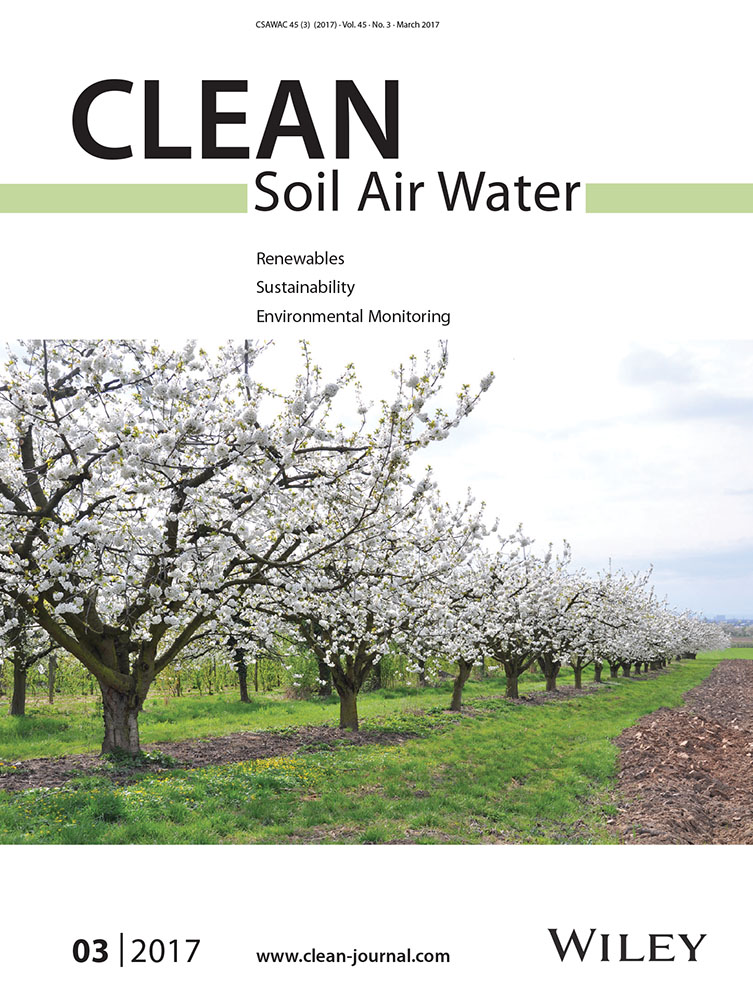Agro-Industrial Effluent Phytoremediation with Lemna gibba and Hydrocotyle ranunculoides in Water Recirculating Mesocosms
Abstract
Treatment of agro-industrial effluents can be carried out via phytoremediation with mono- or multi-specific macrophyte crops. A 6 day phytoremediation assay was performed in mesocosms with continuous recirculation of wastewater from a poultry industry with the macrophytes Lemna gibba and/or Hydrocotyle ranunculoides. The plant effects over removal of nutrients (N, P and C), fecal contamination indicators (total coliforms and Escherichia coli) and the genotoxicity of wastewater by the Allium cepa test were evaluated. A decrease by about 97.6% of total coliforms and E. coli, without significant differences between treatments was observed. The highest removal rates of ammonium (77.9%), dissolved inorganic nitrogen (77.9%), soluble reactive phosphorus (47.6%), total phosphorus (60.6%), and particulate organic carbon (82.1%) were observed in mesocosms with L. gibba + H. ranunculoides, although there were no significant differences (p > 0.05) with respect to the monospecific culture of L. gibba. Lower rates of nutrients removal were observed in monospecific cultures of H. ranunculoides. Moreover, the use of both species meant a reduction of the genotoxicity of wastewater, with no chromosomal aberrations and micronuclei in meristematic root cells of A. cepa. The obtained results confirm the benefits of the joint use of H. ranunculoides and L. gibba for phytoremediation of wastewater from the poultry industry, being preferable to the use of monospecific crops.
Abbreviations
-
- BOD
-
- biochemical oxygen demand
-
- CA
-
- chromosomal aberration
-
- CFU
-
- colony forming unit
-
- COD
-
- chemical oxygen demand
-
- DIN
-
- dissolved inorganic nitrogen
-
- DO
-
- dissolved oxygen
-
- DOC
-
- dissolved organic carbon
-
- DW
-
- dry weight
-
- EC
-
- electrical conductivity
-
- Hr
-
- Hydrocotyle ranunculoides treatment
-
- L
-
- load
-
- Lg
-
- Lemna gibba treatment
-
- Lg + Hr
-
- Lemna gibba and Hydrocotyle ranunculoides treatment
-
- MI
-
- mitotic index
-
- MMS
-
- methyl methanesulfonate
-
- MN
-
- micronucleus
-
- NH4+-N
-
- ammonium nitrogen
-
- NO2−-N
-
- nitrite nitrogen
-
- NO3−-N
-
- nitrate nitrogen
-
- POC
-
- particulate organic carbon
-
- R%
-
- removal percentage
-
- RGR
-
- relative growth rate
-
- SRP
-
- soluble reactive phosphorus
-
- TOC
-
- total organic carbon
-
- TP
-
- total phosphorus
-
- TSS
-
- total suspended solids
-
- UASB
-
- upflow anaerobic sludge blanket
1 Introduction
The effluents produced in many agro-industrial activities are characterized by high concentrations of suspended solids, particulate and dissolved organic matter, and nutrients. The treatment of this wastewater has as main objective the degradation of organic matter through oxidation reactions involving mainly bacteria. This process mimics the natural process of self-purification of water 1. Conventional treatment alternatives such as upflow anaerobic sludge blanket (UASB) result in effluents with low biochemical oxygen demand (BOD5) but high concentrations of nutrients, which must undergo post-treatment before being released into the environment. In particular, poultry meat industries are potential sources of fecal contamination and nutrients to nearby waterways 2.
In addition to organic matter, nutrients, and fecal coliforms, agro-industrial effluents often contain toxic substances whose determination is expensive and do not necessarily reflect their potential toxicity due to antagonistic, additive, or synergistic effects when exposed together with other contaminants. These substances include cleaning products, steroid hormones, antibiotics, metals, ectoparasiticides, among others 3. Toxicity tests are a valuable tool for the detection and quantification of detrimental effects of contaminants on organisms. Higher plants are sensitive to various mutagens and therefore can be used as indicators in its monitoring 4. Allium cepa is one of the species most commonly used to test the toxic effects of wastewater. This species can be used to assess toxicity by macroscopic responses (such as the reduction in the roots length) as well as to evaluate the genotoxicity at the cellular level, for instance, the presence of chromosomal aberrations and micronuclei. These responses are induced because of the high sensitivity of this species to a wide variety of contaminants 5.
Phytoremediation is the use of plants and associated biota for the removal or stabilization of contaminants in water and wastewater and other environmental matrices. The phytoremediation technics have several advantages in comparison to conventional treatments such as lower cost and energy requirement, nutrient recycling, and biomass production, among others. The use of aquatic plants for tertiary treatment of industrial effluents is an alternative implemented in several countries. The effectiveness of some species of the genus Lemna (Lemnaceae) in the phytoextraction of nitrogen compounds from water is well known although phosphorus removal appears to be not significant in all cases 6. Lemna gibba is cited among the most studied and used species 7, 8. Other less-studied macrophytes include species of the genus Hydrocotyle such as H. verticillata, which has been used with other helophytes in the construction of floating islands for purifying eutrophic surface water 9. The species H. ranunculoides, sometimes associated with L. gibba 10, is frequent and abundant in eutrophic water courses of the Pampas plains. These species could contribute to the removal of excess nutrients, suspended material, organic matter, and coliform bacteria in effluents from agro-industrial activity, through systems of wastewater treatment or on-site remediation of water bodies. Furthermore, treatment may reduce the genotoxicity of effluents. Ansari et al. 11 suggest that the use of several species of macrophytes can increase the efficiency of removal of N and P.
The aim of this study was to compare the efficacy in nutrients removal and decreasing toxicity of an agro-industrial effluent, through phytoremediation with duckweed species (L. gibba), H. ranunculoides, and a mixed culture of both species in mesocosms with water recirculation.
2 Materials and methods
2.1 Sampling and cultivation of Lemna gibba and Hydrocotyle ranunculoides
Lemna gibba specimens were collected in the reservoir Ing. Carlos F. Roggero (34° 41′ 11.32″ S, 58° 51′ 59.12″ W). Hydrocotyle ranunculoides specimens were collected from cultivation ponds located at the Museo Argentino de Ciencias Naturales “Bernardino Rivadavia.”
2.2 Bioassay with continuous recirculation of wastewater
For acclimatization purposes, individuals of both species were placed for a week in containers filled with effluent from a poultry industry discharged into the La Choza stream (General Rodriguez, Buenos Aires, 34° 39′ 48.64″ S, 58° 56′ 44.43″ W). After the acclimatization period, individuals of similar size and weight grown in greenhouse were selected. Nine independent continuous flow reactors were installed each filled with 9 L undiluted wastewater (Fig. 1). A submersible pump was installed in each container for the continuous recirculation of the wastewater at a rate of 0.6 mL/s, in order to recreate the low current velocities of constructed wetlands for effluent treatment 12. An equivalent amount of biomass of 1.21 ± 0.04 g (dry weight, DW) of L. gibba (Lg treatment), H. ranunculoides (Hr treatment) or both species together (Lg + Hr treatment, 50% w/w of each species) was placed in each randomly selected mesocosm. The reactors were placed in greenhouse with natural and controlled artificial light photoperiod of 16:8 (light/dark) for 6 days.
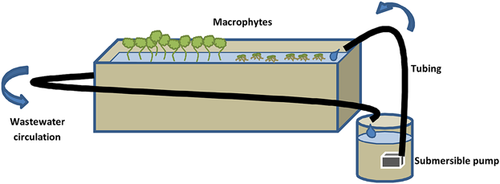
2.3 Analytical determinations
Water samples were collected from each reactor at the beginning and at the end of the assay, determining the physical and chemical variables listed in Table 1 by means of standardized methodologies 13-17.
| Variable | Methodology | Reference |
|---|---|---|
| Temperature (T) | Alcohol thermometer | |
| pH | pH-meter (Hanna®) | |
| Electrical conductivity (EC) | EC-meter (Hanna®) | |
| Total suspended solids (TSS) | Gravimetry | 13 |
| Dissolved oxygen (DO) | Oxymeter (Hanna®) | |
| Ammonium nitrogen (NH4+-N) | Blue indophenol | 14 |
| Nitrite nitrogen (NO2−-N) | Diazotization | 15 |
| Nitrate nitrogen (NO3−-N) | Reduction with hydrazine sulfate and Cu2+ and Zn2+ ions | 16 |
| Dissolved inorganic nitrogen (DIN) | Sum of ammonium, nitrate and nitrite nitrogen | |
| Soluble reactive phosphorus (SRP) | Ascorbic molybdate | 15 |
| Total phosphorus (TP) | Ascorbic molybdate, after digestion with H2SO4 and potassium persulfate | 15 |
| Biochemical oxygen demand (BOD5) | DO measurement | 13 |
| Chemical oxygen demand (COD) | Chemical oxidation | 13 |
| Total and dissolved organic carbon (TOC and DOC) | Oxidation in acid medium | 17 |
| Particulate organic carbon (POC) | TOC–DOC difference |
 (1)
(1)2.4 Count of total coliforms and Escherichia coli
Determination of total coliform bacteria and E. coli was carried out by plate count technique to assess water quality. Briefly, 1 mL of decimal serial dilutions of the sample were inoculated in selective and differential medium CHRO ECC Agar (CHROMagar©). Plates were incubated at 35°C for 48 h 13.
2.5 Allium cepa genotoxicity test
A wastewater mutagenicity test was performed, following the methodology described by Matsumoto et al. 20. A homogeneous seed lot of A. cepa grown under organic conditions (variety Valcatorce) was used for the test. The seeds of this species are preferred because of their genetic and physiological homogeneity and their availability throughout the year. A total of 100 seeds were placed in Petri dishes containing filter paper inoculated with 5 mL of sample or control. Distilled water was used as a negative control and methyl methanesulfonate (MMS) 2 × 10−4 M as a positive control. Wastewater samples were collected at the beginning and at the end of the assay for each treatment (Lg, Hr, and Lg + Hr). The plates were kept at 22–24°C for 4 days. The seeds with their roots were fixed for 24 h in acetic Carnoy, then washed with distilled water and preserved in 70% ethanol for later observation 21. Chromosomes of meristematic root cells were stained with orcein in 2% acetic acid. A total of 5000 cells were counted in at least five slides. The mitotic index (MI) in 5000 cells and the frequency of chromosomal aberrations (CA) in metaphase and anaphase (bridges, fragments, delayed chromosomes, and others) were analyzed for a total of at least 200 anaphases. The frequency of micronuclei (MN) in 2000 interfaces was analyzed as well.
2.6 Statistical analysis
The existence of statistically significant differences (p < 0.05) between the values of concentrations or loads of variables were determined by analysis of variance (ANOVA) test with post hoc Tukey or Dunnett comparisons as appropriate. Non-normal variables and/or heteroskedastic were previously transformed 22. Genotoxicity data from A. cepa test were analyzed using the Kruskal–Wallis test 20.
3 Results and discussion
3.1 Physical and chemical variables
During the test, the water temperature in the reactors was 25 ± 5°C. The pH increased throughout the test, reaching a peak of 8.79 on day 5 of treatment with Lg + Hr (Fig. 2). The increase in all treatments could be associated to the notorious periphyton growth on the walls of all containers (data not shown), which promoted photosynthesis and thus increased pH 23.
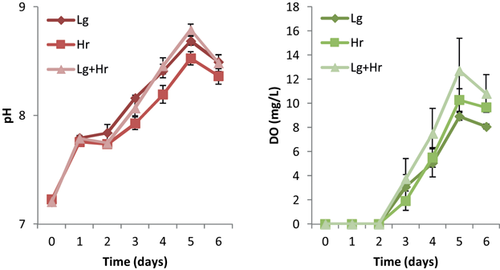
The average electrical conductivity (EC) at the start of the trial was within the range of 1388–1394 μS/cm, increasing in all treatments towards the end of the trial by the effect of evapotranspiration, with a maximum value of 1430 μS/cm in the Hr treatment. This effect was less noticeable in the Lg treatment.
The value of dissolved oxygen (DO) concentration was 0 mg/L in all reactors during the first 2 days, and can be attributed to anoxic fermentation and remineralization resulting from bacterial activity. Then, DO increased gradually until day 5, with a maximum average value of 12.73 mg/L in the Lg + Hr treatment; most variability between replicates was observed in this treatment (Fig. 2). In sparse vegetation, oxygen production may exceed respiration resulting in an oxygen surplus, whereas the opposite may occur in dense vegetation 24. Subsequently, at the end of the test a slight decrease in DO concentration was observed in all treatments, although values remain close to saturation. It should be noted that measurements were performed daily at the same time to avoid changes by photosynthetic activity occurring during the day. The mean concentration of total suspended solids (TSS) in wastewater at the beginning of the assay was 141 mg/L. Similar reductions of TSS concentration were observed in all treatments, with mean final values between 13 and 18 mg/L.
In all treatments, ammonium (NH4+-N) was the primary nitrogenous form at the start and at the end of the assay while nitrite (NO2−-N) and nitrate (NO3−-N) concentrations were always very low (<0.05 mg/L). The final concentrations of NH4+-N and DIN were significantly lower than the initial ones (Fig. 3). The assimilation of ammonium nitrogen by macrophytes and periphyton along with denitrification that occurred in the anoxic environment of the early stage of the experiment, resulted in a removal of 74.1% in the Lg treatment, 65.7% in the Hr treatment, and 77.9% in the Lg + Hr treatment (Table 2). The greater efficiency in nutrients uptake in mixed cultures could be associated with the largest area to hold periphyton. Studies showed that this community plays an important role in nutrients uptake 25. In addition, Levi et al. 26 proposed that the coexistence of different species of macrophyte increases the efficiency of ammonium uptake, thus higher concentrations may be processed before it is saturated. Cardinale 27 argued that systems with more biological diversity can better exploit niche opportunities because they can develop different strategies that optimize the process of resources uptake, in this case N.
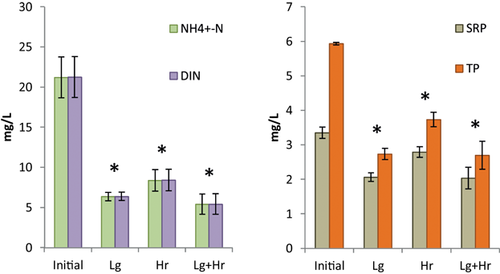
| Variable | Treatment | Initial L (mg/reactor) | Final L (mg/reactor) | p-value | R% |
|---|---|---|---|---|---|
| Lg | 141 ± 22a | 88.9 ± 1.7 | |||
| TSS | Hr | 1268 ± 81 | 99 ± 25a | 0.161 | 92.2 ± 2.0 |
| Lg + Hr | 117 ± 22a | 90.8 ± 1.7 | |||
| Lg | 49.39 ± 4.39a,b | 74.1 ± 2.3 | |||
| NH4+-N | Hr | 190.91 ± 23.08 | 65.40 ± 9.93a | 0.040* | 65.7 ± 5.2 |
| Lg + Hr | 42.12 ± 10.16b | 77.9 ± 5.3 | |||
| Lg | 49.54 ± 4.40a,b | 74.1 ± 2.3 | |||
| DIN | Hr | 191.18 ± 23.08 | 65.58 ± 9.94a | 0.040* | 65.7 ± 5.2 |
| Lg + Hr | 42.26 ± 10.20b | 77.9 ± 5.3 | |||
| Lg | 16.00 ± 1.10a | 47.0 ± 3.7 | |||
| SRP | Hr | 30.18 ± 1.46 | 21.75 ± 1.03b | 0.008** | 27.9 ± 3.4 |
| Lg + Hr | 15.83 ± 2.52a | 47.6 ± 8.3 | |||
| Lg | 21.23 ± 1.40a | 60.2 ± 2.6 | |||
| TP | Hr | 53.40 ± 0.33 | 29.13 ± 1.30b | 0.006** | 45.4 ± 2.4 |
| Lg + Hr | 21.02 ± 3.25a | 60.6 ± 6.1 | |||
| Lg | 130.0 ± 3.6a,b | 77.6 ± 0.6 | |||
| TOC | Hr | 580.5 ± 17.1 | 166.0 ± 16.8a | 0.024* | 71.4 ± 2.9 |
| Lg + Hr | 138.7 ± 11.4b | 76.2 ± 2.0 | |||
| Lg | 82.0 ± 4.4a | 75.0 ± 1.4 | |||
| DOC | Hr | 326.9 ± 77.4 | 99.7 ± 13.1a | 0.194 | 69.5 ± 4.1 |
| Lg + Hr | 93.0 ± 11.8a | 71.5 ± 3.6 | |||
| Lg | 48.0 ± 6.6a | 81.0 ± 2.6 | |||
| POC | Hr | 253.7 ± 71.5 | 66.7 ± 7.2b | 0.015* | 73.8 ± 2.8 |
| Lg + Hr | 45.3 ± 6.0a | 82.1 ± 2.5 |
- The asterisk (*) indicates statistically significant differences (p < 0.05) or highly significant (**) (p < 0.01) between the final loads of treatments Lg, Hr, and Lg + Hr. The same letters (a, b) indicate membership to homogeneous groups according to Tukey post hoc comparison (p < 0.05).
The initial concentration of SRP in the wastewater was 3.35 mg/L and the concentration of TP was 5.93 mg/L, with a SRP/TP ratio of 0.565. Concentrations of SRP and TP in the wastewater were significantly reduced in all treatments after 6 days (Fig. 3). Values of the SRP/TP ratio at the end were higher than at the beginning of the experiment for all treatments; the values were 0.752, 0.748, and 0.752 in Lg, Hr, and Lg + Hr, respectively. These values indicate the progress of bacterial degradation and deposition of particulate matter throughout the test, increasing the dissolved inorganic fraction of P. At the start of the assay, the particulate fraction of P was 43.5% of TP and at the end it was reduced to 10%, which reveals the importance of adsorption, complexation, and sedimentation indicated by Brix 28 as the main factors in the decrease of P in artificial wetlands. Co-precipitation of P is favored in the Pampas streams where the substrates have high content of CaCO3 29. Ansari et al. 11 found that the removal of N and P was up to 92 and 78%, respectively, in cultures of more than one species of macrophytes (Eichhornia + Spirodela + Lemna) and was higher than in monocultures of each single species.
The maximum COD reduction was 70.6%, observed in the Lg + Hr treatment, with a final concentration of 160 mg/L (Fig. 4). From stoichiometry calculations, biodegradable organic matter should become microbial biomass or mineralized in 5 days. However, the nature of the organic matter and certain environmental conditions such as lighting can alter this simple stoichiometric relationship. Given the test results, conditions were favorable for attenuating BOD5 levels, which dropped as much as 96.9% in the Lg treatment, with a final value of 10.4 mg/L (Fig. 4). This decrease was mainly due to bacterial degradation and deposition of particulate matter on the surface of containers and plants 28. Depletion of DO in the first two days of the test (deoxygenation step) was achieved due to active bacterial degradation. However, from then until the end of the trial DO levels increased up to supersaturation (Fig. 2). Possibly, aerobic and facultative bacterial activity was very intense and efficient during the first 2 days rapidly consuming the DO incorporated by diffusion and water movement and depleting the amount of biodegradable material. Then, bacterial activity decreased and DO levels grew by photosynthetic activity of periphyton, oxygenation from the roots of the macrophytes 30 and the positive balance in oxygenation by diffusion from the atmosphere by the movement of water circulation 8. The BOD5/COD ratio was 0.62 at the start and decreased over time, with a minimal final value of 0.06 (Lg treatment) and a maximum final value of 0.12 (Hr treatment). The initial value of the ratio is as expected (0.6) in wastewater with a high proportion of readily biodegradable organic matter, such as municipal wastewater 31. Initial concentrations of BOD5 and nutrients were similar to those reported by Basílico et al. 32.

Loads of nutrients were calculated for each reactor at the start and at the end of the assay (Table 2). Statistically significant differences (p < 0.05) between the final loads of NH4+-N, DIN, TOC, and POC and highly significant differences (p < 0.01) between final loads of SRP and TP were found for the different treatments (Table 2). In the case of NH4+-N, DIN, SRP, TP, and POC final loads (L) were in the order of LHr > LLg > LLg+Hr, while for TOC of LHr > LLg+Hr > LLg. While an important removal for these variables was achieved in all treatments, the performance of the Hr treatment was lowest in most cases, except for TSS (Table 2). DIN and TP %R were higher than those reported by Basílico et al. 13 in the effluent bio-treatment with S. intermedia and periphyton.
The initial value of total coliforms and E. coli was 210 CFU/mL and both indices dropped to 5 CFU/mL (Hr and Lg + Hr treatments) and 9 CFU/mL (Lg treatment) (Fig. 5). While the initial load of coliforms indicators in wastewater was low compared to other effluents of similar characteristics, a reduction of 97.6% was reached in the Hr and Lg + Hr treatments. This value is similar to that obtained in wastewater pathogen removal treatments using constructed wetlands 33 but lower than the typical 99% reduction expected in a chemical disinfection treatment 31. The decrease of total coliforms and E. coli determined after the test reveals the efficiency of the treatment in wastewaters with moderate or low pathogen load as the one used in the assay. However, this decrease cannot be attributed to a particular species or to the presence of both. The need for subsequent disinfection of the effluent prior to its discharge into a water body should be pointed out.
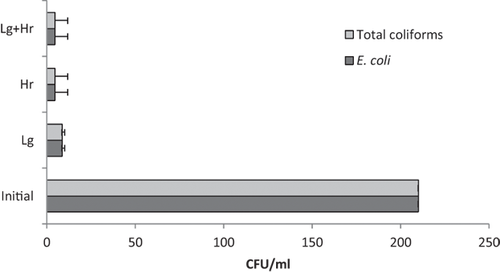
3.2 Plant biomass production
The final biomass of L. gibba (Lg treatment) was 1.61 ± 0.29 g DW, with a relative growth rate RGR of 0.051 day−1. For H. ranunculoides the final biomass was 1.95 ± 0.14 g DW, with an RGR of 0.075 day−1 and in the Lg + Hr treatment the final biomass of both species was 1.87 ± 0.26 g DW and the global RGR in this case was 0.071 day−1. Concentrations of nutrient elements in the assay exceeded those in conventional cultures 34. However, the growth rates in the assay were much lower than the growth rate in the culture media. The effect probably resulted from the gradient change occurring in the recirculating mesocosm, which might induce stress in plants. Most Lemnaceae species are sometimes sensitive to changes in the environment 34. Expected growth of macrophytes would be higher in a full-scale application of effluent phytoremediation; in that case, the nutrients supply is higher as it takes place in a continuous flow system or in batch where the surface/volume ratio of ponds is smaller compared to that of the assay.
3.3 Allium cepa genotoxicity test
The A. cepa test allows analysis of the cytotoxic and genotoxic effects of environmental samples on meristematic root cells. Thus, the cytotoxicity is evaluated from the analysis of MI, and genotoxicity from CA and MN frequencies. Both the initial sample of the effluent from the poultry industry and the samples of the three treatments showed a significant higher MI value over the negative control (Table 3). This would indicate the absence of cytotoxic agents. However, an increase in cell division could be dangerous due to the possible proliferation of cells that could result in unordered tumor tissues 5. According to the values of CA frequencies, the initial sample and the three treatments showed no significant differences with respect to the control. However, higher values were observed in MN frequencies in the initial sample and in treatments Lg and Hr, indicating the presence of mutagens. The Lg + Hr treatment was effective in eliminating or reducing the genotoxicity in wastewater, since no chromosomal aberrations or micronuclei were recorded.
| Treatment | MI | CA | MN |
|---|---|---|---|
| Negative control | 39.77 ± 4.41 | 0.01 ± 0.02 | 0.07 ± 0.09 |
| Initial | 58.46 ± 7.85* | 0.17 ± 0.42 | 1.21 ± 0.61* |
| Lg | 59.97 ± 16.27* | 0.34 ± 0.44 | 1.09 ± 1.18* |
| Hr | 48.73 ± 7.02* | 0.19 ± 0.26 | 0.38 ± 0.25* |
| Lg + Hr | 62.14 ± 6.89* | 0.00 ± 0.00 | 0.00 ± 0.00 |
| MMS | 55.54 ± 1.41* | 0.82 ± 0.29* | 5.89 ± 1.76* |
- The asterisk (*) indicates significant differences compared to the negative control (p < 0.05) by Kruskal–Wallis test.
4 Concluding remarks
Lower rates of nutrients removal from wastewater were observed in the monospecific culture of H. ranunculoides. The joint use of L. gibba and H. ranunculoides allowed more efficient removal of ammonium, DIN, SRP, TP, and POC, but without marked differences with the monospecific culture of L. gibba. The removal of suspended material was higher when using a monoculture of H. ranunculoides.
The decrease in indicators of fecal pollution load was similar in mono- and multi-specific crops. However, the use of both species meant a reduction of the genotoxicity of wastewater for A. cepa, with no chromosomal aberrations and micronuclei observed. The obtained results confirm that the combined use of L. gibba and H. ranunculoides for phytoremediation of wastewater from the poultry industry is preferable to the use of a single species.
Acknowledgments
The authors wish to thank Ignacio Healión and Roberto Ferrer from Área Natural Protegida “Dique Ing. Roggero” for their assistance in sampling. Brenda Van Hauvart collaborated with the revision of the manuscript in English. The authors are grateful to Ricardo J. Piccolo from INTA, La Consulta (Mendoza, Argentina) for kindly providing the Allium cepa seeds. This work was supported by National Council of Scientific and Technical Research [PIP CONICET 0323] and University of Flores.
The authors have declared no conflict of interest.



